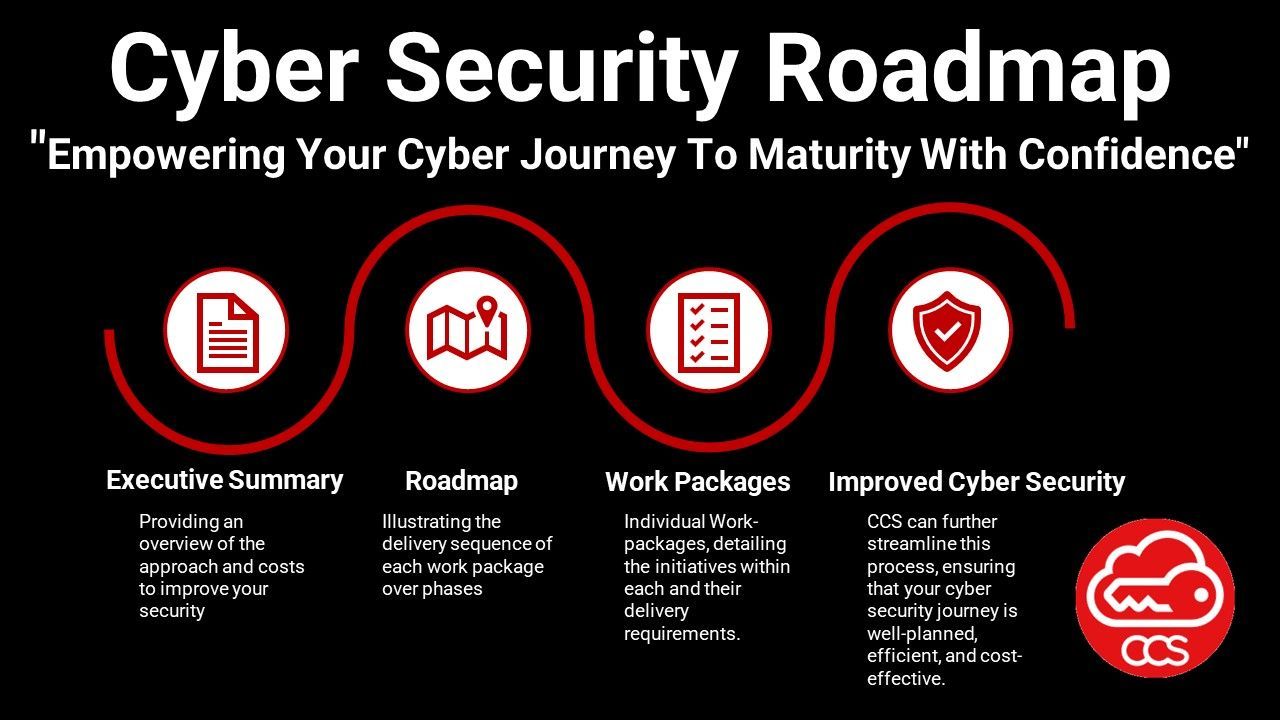Why Implement a Cyber Security Roadmap
After a Cyber Security Posture Review?
In today's digital age, cyber threats are not just a possibility—they're a certainty. Organizations must constantly evolve to stay ahead of increasingly sophisticated cyber-attacks. Conducting a Cyber Security Posture Review (CSPR) is a crucial first step in identifying vulnerabilities and understanding your current security landscape. However, to transform insights from a CSPR into actionable improvements, a Cyber Security Roadmap (CSR) is essential. This roadmap guides organizations through a structured, strategic plan for enhancing their cybersecurity posture, ensuring they are equipped to handle future threats and achieve cyber maturity.
The Necessity of a Cyber Security Posture Review
A CSPR offers a comprehensive evaluation of an organization's security measures. It identifies vulnerabilities, assesses the effectiveness of existing controls, and provides actionable recommendations. Understanding your cyber security posture is critical for several reasons:
- Identifying Weaknesses:
- A CSPR uncovers potential vulnerabilities that could be exploited by cybercriminals, providing a clear picture of where improvements are needed.
- Building Trust:
- By understanding and improving your cyber security posture, you build confidence among customers, partners, and stakeholders, demonstrating your commitment to protecting their data.
- Compliance and Risk Management:
- A CSPR helps ensure compliance with regulations such as GDPR or HIPAA and enables proactive risk management.
However, the findings of a CSPR are just the beginning. To address the identified risks and vulnerabilities effectively, organizations need a detailed plan—this is where a Cyber Security Roadmap (CSR) comes into play.
What is a Cyber Security Roadmap (CSR)?
A Cyber Security Roadmap (CSR) is a strategic plan that outlines the steps needed to enhance an organization's cybersecurity posture. It translates the insights and recommendations from a CSPR into a clear, actionable strategy, addressing key aspects such as budget allocation, resource requirements, capacity planning, and implementation timeframes.
The Benefits of a Cyber Security Roadmap
- Strategic Planning and Prioritization:
- A CSR helps prioritize cybersecurity initiatives based on the severity of identified risks and the organization’s strategic objectives. This ensures that the most critical vulnerabilities are addressed promptly, and resources are allocated efficiently.
- Comprehensive Resource Allocation:
- The roadmap details the financial, technological, and human resources needed to implement the recommended security measures. This includes staffing, training, external support, and technology investments, providing a clear picture of the resources required to achieve cybersecurity goals.
- Budget Management:
- A CSR provides a transparent breakdown of the financial resources needed for each phase of the cybersecurity improvements. This ensures that budget planning is aligned with the organization’s security objectives, making it easier to secure the necessary funding and manage financial resources effectively.
- Capacity Planning:
- Effective capacity planning is crucial for implementing cybersecurity enhancements. The CSR outlines the capacity requirements, helping organizations understand and prepare for the workload associated with new security measures.
- Defined Timeframes and Accountability:
- The roadmap assigns specific timeframes to each task, ensuring that all activities are completed on schedule. This structured approach facilitates better planning and monitoring, keeping the organization on track towards its cybersecurity objectives.
- Enhanced Security Resilience:
- By systematically addressing the vulnerabilities identified in the CSPR, the CSR helps build a more resilient security posture. This reduces the likelihood of breaches and enhances the organization’s ability to respond to potential threats.
The CCS Approach to Cyber Security Roadmaps
At CCS, we understand that improving cybersecurity is a continuous journey. Our approach to creating a Cyber Security Roadmap involves:
- Incorporating Existing Plans:
- We consider any in-progress or planned improvements identified during the CSPR, providing a unified roadmap for all security initiatives.
- Tailored Solutions:
- Our CSR is customized to align with your specific business goals and objectives, ensuring that the cybersecurity measures are appropriate for your organization's needs.
- Vendor and Product Selection:
- As an independent consultancy, we provide unbiased advice, helping you select the right security vendors and products. We assist with procurement, ensuring that your investments are both cost-effective and high-quality.
- Ongoing Support:
- Beyond planning, we offer support through the configuration, installation, and ongoing maintenance of security solutions, ensuring that your cybersecurity strategy is fully implemented and sustainable.
Why a CSR is Crucial After a CSPR
A CSPR provides a snapshot of your current cybersecurity posture, highlighting where improvements are needed. However, without a Cyber Security Roadmap, the insights gained from a CSPR may not translate into effective action. A CSR ensures that identified vulnerabilities are addressed systematically and that your organization progresses towards a mature, resilient cybersecurity posture. It provides a clear path forward, helping you allocate resources wisely, plan capacity effectively, and maintain a focus on continuous improvement.
In an era of relentless cyber threats, a Cyber Security Roadmap is not just a strategic advantage; it’s a necessity. It empowers organizations to navigate the complexities of cybersecurity, ensuring that they are well-prepared to defend against evolving threats and maintain the trust of their customers and stakeholders.
Partnering with CCS can streamline this process, providing expert guidance and support throughout your cybersecurity journey.




